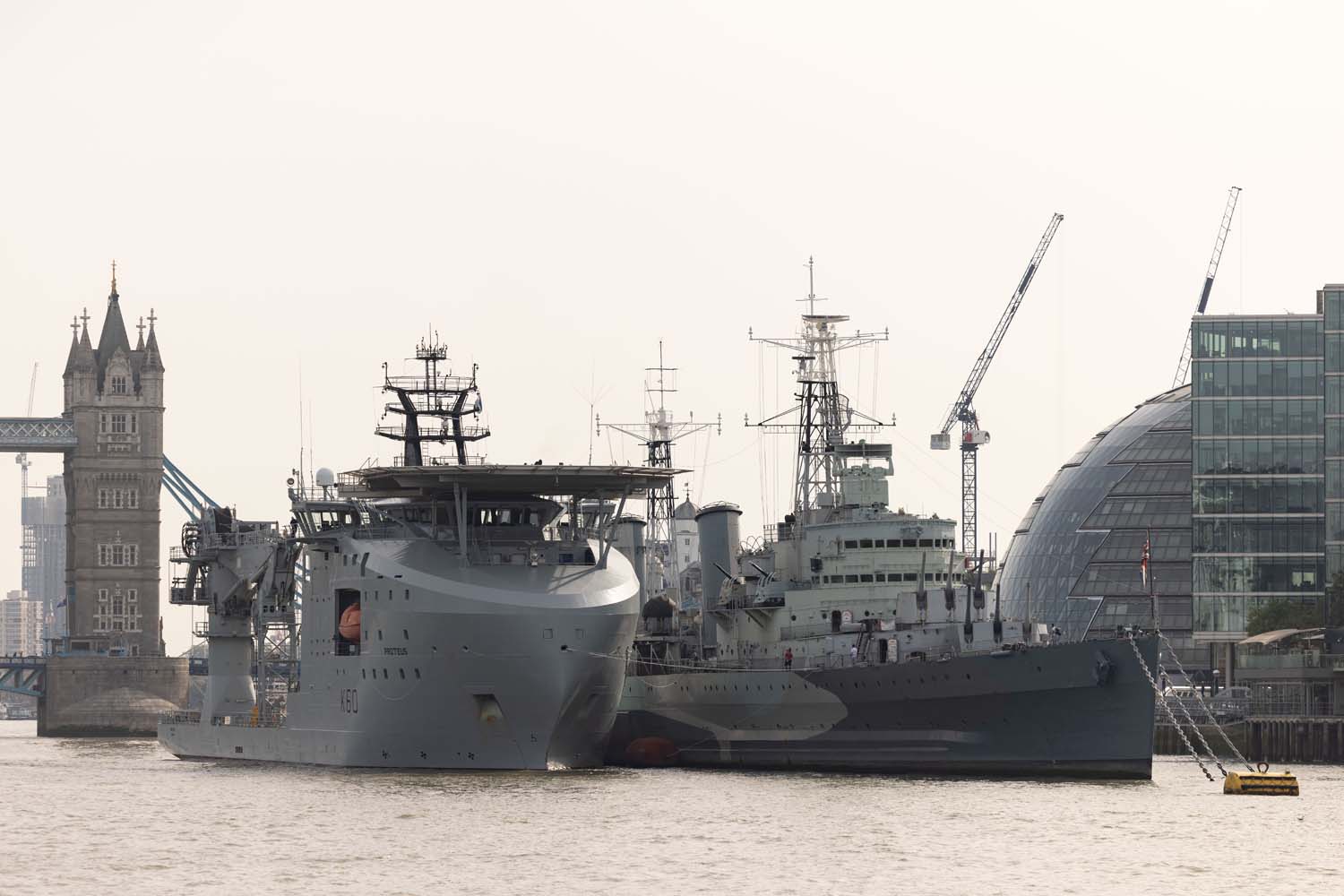In a momentous event in London on October 10, the first underwater surveillance vessel of the United Kingdom, RFA Proteus, officially joined the ranks of the Royal Fleet Auxiliary (RFA).
Proteus is the first of the two Multi-Role Ocean Surveillance (MROS) ships the United Kingdom procured for underwater surveillance and seabed warfare.
These vessels will be under the operation of the Royal Fleet Auxiliary (RFA), the crucial support arm of the Royal Navy. The ship, RFA Proteus, was officially named during a ceremony on the Thames River.
The event was attended by the RFA Commodore-in-Chief, Prince Edward, The Duke of Edinburgh, and Akshata Murty, the spouse of Prime Minister Rishi Sunak, who will serve as Proteus’ sponsor for its entire operational period.
The ship, formerly MV Topaz Tangaroa, was acquired by the UK Ministry of Defence (MoD) as a secondhand purchase from P&O Maritime Logistics’ subsidiary, Topaz Energy and Marine, in late 2022.

It arrived at the Cammell Laird shipyard in Birkenhead in January 2023 for necessary modifications to prepare it for its new role.
As the Royal Navy (RN) stated, the conversion work was finished in September. Subsequently, the ship underwent a short phase of trials and training off the coast of Portland before the dedication ceremony.
The ship, crewed by 26 RFA officers and sailors and bolstered by 60 Royal Navy specialists overseeing undersea surveillance, survey, and warfare systems, initially served as an oil rig support vessel before its current role.
The vessel was originally built in 2019 by Norwegian shipbuilder Vard as an offshore support vessel. In its original capacity, it played a vital role in supporting various underwater activities, including work on oil rigs, construction, maintenance, inspections, and even autonomous submarine operations in the offshore oil industry.
Commodore David Eagles, head of the Royal Fleet Auxiliary, said: “It is a huge honor and responsibility for the Royal Fleet Auxiliary to be charged with crewing and operating RFA Proteus and delivering her unique, sovereign capability in partnership and collaboration with our Royal Navy, Defence, and Government agency colleagues.”
Importance Of Proteus Multi-Role Ocean Surveillance (MROS) Vessel
The vessel has a displacement of 6,000 tonnes and features a total length of 98.1 meters along with a beam of 20 meters. It also has a flight deck, a 1,000-square-meter cargo deck, and a robust crane for lifting and lowering operations.
According to the UK Navy, Proteus will serve as a testbed for driving scientific and technological progress, ensuring the United Kingdom retains its competitive advantage in underwater operations.
Initially designed for a wide range of seabed operations, Proteus is well-prepared for its new mission of monitoring Critical Undersea Infrastructure (CUI). Several features of this vessel are unique to the Naval Service, which hasn’t operated a similar vessel since the retirement of HMS Challenger in 1990.
One of these unique features is the 7.2 x 7.2-meter moonpool located at the forward end of the working deck. This moonpool provides a sheltered area for launching or recovering submersibles, even in high-sea conditions where conventional over-the-side systems would be impractical.
The deck hatch is removed by crane and stored vertically on the port side to enable its use. Proteus is also equipped with an AHC crane boasting a 3,000-meter-long wire, which allows for directly lowering items to the seabed, extending well beyond the continental shelf.
With a robust, safe working load of up to 120 tonnes, the crane can efficiently handle large infrastructure equipment, machinery, or heavy submersibles.
The working deck can carry a total load of up to 1,400 tonnes, making it suitable for accommodating items like Unmanned Underwater Vehicles (UUVs), supplies, and other equipment housed in TEU containers.
Proteus hosts a two-ROV hangar with dual-sided launch and recovery systems. The ROVs, equipment, and sensors are connected via an umbilical tether managed by the ship’s winch system.

Adjoining the hangar are maintenance workshops, data storage, and control rooms. The vessel supports hydrography, featuring a Multi-beam Echo Sounder for seabed surveys, and offers ample space for mission planning and command and control.
During the Royal United Services Institute’s Gallipoli Memorial Lecture in London on September 6, Admiral Sir Ben Key, the RN’s First Sea Lord and Chief of Naval Staff, outlined the operational advantages that Proteus will bring in meeting the requirements for Covert Underwater Infrastructure Warfare (CUIW) capability.
He mentioned that Proteus would be deployed to protect the UK’s critical national infrastructure on the seabed by utilizing advanced sensors, autonomous vehicles, and submersibles.
Admiral Key stressed the ongoing reality of CUI threats, especially in light of the potential strategic implications of the Russo-Ukraine conflict.
He pointed out that the attack on the Nordstream pipelines in 2022, although unattributed, highlighted the vulnerability of critical national infrastructure on the seabed.
This infrastructure, including cables and pipelines for gas, electricity, and data transmission, crisscrosses the UK’s seabed and extends across the vast, ungoverned expanse of the world’s oceans, making it a matter of international concern.
- Contact the author at ashishmichel(at)gmail.com
- Follow EurAsian Times on Google News




